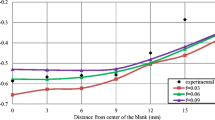Abstract
In this study, different techniques used for modelling of bimetallic sheets by finite element (FE) method have been compared. Sheets modelled with five different assumptions were compared with each other and experimental data to determine the FE model that gives the most realistic result. FE models were created with the assumption that the adhesion was excellent or separable and with the case that the solidified adhesive in the intermediate layer was modelled and not modelled. As a result, the closest values to the experimental results were obtained with the model created with the assumption that there is a solidified adhesive layer in the middle layer and there is an adhesion interface between this layer and metallic layers. On the other hand, when the adhesive is not modelled in the middle layer, it has been observed that the solution time is reduced by 2.6 times while small changes are seen in the results.



















Similar content being viewed by others
Data availability
The authors shared all data and materials in manuscript.
Code availability
Code available and can be share if necessary.
References
Mori T, Kurimoto S (1996) Press-formability of stainless steel and aluminum clad sheet. J Mater Process Technol 56:242–253
Chen C-Y, Kuo J-C, Chen H-L, Hwang W-S (2006) Experimental investigation on earing behavior of aluminum/copper bimetal sheet. Mater Trans 47:2434–2443. https://doi.org/10.2320/matertrans.47.2434
Morovvati MR, Fatemi A, Sadighi M (2011) Experimental and finite element investigation on wrinkling of circular single layer and two-layer sheet metals in deep drawing process. Int J Adv Manuf Technol 54:113–121
Aghchai AJ, Shakeri M, Dariani BM (2013) Influences of material properties of components on formability of two-layer metallic sheets. Int J Adv Manuf Technol 66:809–823
Afshin E, Kadkhodayan M (2015) An experimental investigation into the warm deep-drawing process on laminated sheets under various grain sizes. Mater Des 87:25–35. https://doi.org/10.1016/j.matdes.2015.07.061
Takuda H, Mori K, Fujimoto H, Hatta N (1996) Prediction of forming limit in deep drawing of Fe/Al laminated composite sheets using ductile fracture criterion. J Mater Process Technol 60:291–296
Parsa MH, Yamaguchi K, Takakura N (2001) Redrawing analysis of aluminum–stainless-steel laminated sheet using FEM simulations and experiments. Int J Mech Sci 43:2331–2347. https://doi.org/10.1016/S0020-7403(01)00038-8
Bagherzadeh S, Mirnia MJ, Mollaei Dariani B (2015) Numerical and experimental investigations of hydro-mechanical deep drawing process of laminated aluminum/steel sheets. J Manuf Process 18:131–140. https://doi.org/10.1016/j.jmapro.2015.03.004
Marandi FA, Jabbari AH, Sedighi M, Hashemi R (2016) An experimental, analytical, and numerical investigation of hydraulic bulge test in two-layer Al–Cu Sheets. J Manuf Sci Eng 139:031005. https://doi.org/10.1115/1.4034717
Sakhtemanian MR, Honarpisheh M, Amini S (2017) Numerical and experimental study on the layer arrangement in the incremental forming process of explosive-welded low-carbon steel/CP-titanium bimetal sheet. Int J Adv Manuf Technol 95:3781–3796. https://doi.org/10.1007/s00170-017-1462-z
Karajibani E, Hashemi R, Sedighi M (2017) Forming limit diagram of aluminum-copper two-layer sheets: numerical simulations and experimental verifications. Int J Adv Manuf Technol 90:2713–2722. https://doi.org/10.1007/s00170-016-9585-1
Tseng H-C, Hung C, Huang C-C (2010) An analysis of the formability of aluminum/copper clad metals with different thicknesses by the finite element method and experiment. Int J Adv Manuf Technol 49:1029–1036
Hasan Nejad SJ, Hasanzadeh R, Doniavi A, Modanloo V (2017) Finite element simulation analysis of laminated sheets in deep drawing process using response surface method. Int J Adv Manuf Technol 93:3245–3259. https://doi.org/10.1007/s00170-017-0780-5
Atrian A, Fereshteh-Saniee F (2013) Deep drawing process of steel/brass laminated sheets. Compos Part B Eng 47:75–81. https://doi.org/10.1016/j.compositesb.2012.10.023
Liu J, Xue W (2013) Formability of AA5052/polyethylene/AA5052 sandwich sheets. Trans Nonferrous Metals Soc China 23:964–969. https://doi.org/10.1016/S1003-6326(13)62553-4
Liu J, Zhuang L (2018) Cylindrical cup-drawing characteristics of aluminum-polymer sandwich sheet. Int J Adv Manuf Technol 97:1885–1896
Abaqus Manual (2007) Abaqus/explicit: user’s examples and theory manuals. Dassault systemes
Liu J, Liu W, Xue W (2013) Forming limit diagram prediction of AA5052/polyethylene/AA5052 sandwich sheets. Mater Des 46:112–120. https://doi.org/10.1016/j.matdes.2012.09.057
ASTM D1876-08 (2015) Standard Test Method for Peel Resistance of Adhesives (T-Peel Test), ASTM International, West Conshohocken, PA. www.astm.org
Papazafeiropoulos G, Muñiz-Calvente M, Martínez-Pañeda E (2017) Abaqus2Matlab: A suitable tool for finite element post-processing. Adv Eng Softw 105:9–16. https://doi.org/10.1016/J.ADVENGSOFT.2017.01.006
ASTM D1002-10 (2010) Standard Test Method for Apparent Shear Strength of Single-Lap-Joint Adhesively Bonded Metal Specimens by Tension Loading (Metal-to-Metal), ASTM International, West Conshohocken, PA. www.astm.org
Acknowledgements
Special thanks to Mech. Eng. Gürkan Kara for his collaborations in this work.
Funding
This study was financially supported by Turkish Council of Higher Education under scholar grad: ÖYP-1919-018, TUBITAK BIDEP 2211-A and Ondokuz Mayıs University Scientific Researched Project Department [grant number PYO.MUH.1905.16.002].
Author information
Authors and Affiliations
Contributions
Cengiz Görkem Dengiz: conceptualization, methodology, investigation, resources, data curation, writing-original draft, visualization, software, validation, formal analysis and Kemal Yıldızlı: writing-review & editing, supervision.
Corresponding author
Ethics declarations
Conflict of interest
The authors declare no competing interests.
Additional information
Publisher’s note
Springer Nature remains neutral with regard to jurisdictional claims in published maps and institutional affiliations.
Rights and permissions
About this article
Cite this article
Dengiz, C.G., Yildizli, K. Experimental and simulated comparison of finite element models of bimetallic sheets for deep drawing process. Int J Adv Manuf Technol 117, 3599–3614 (2021). https://doi.org/10.1007/s00170-021-07944-0
Received:
Accepted:
Published:
Issue Date:
DOI: https://doi.org/10.1007/s00170-021-07944-0




